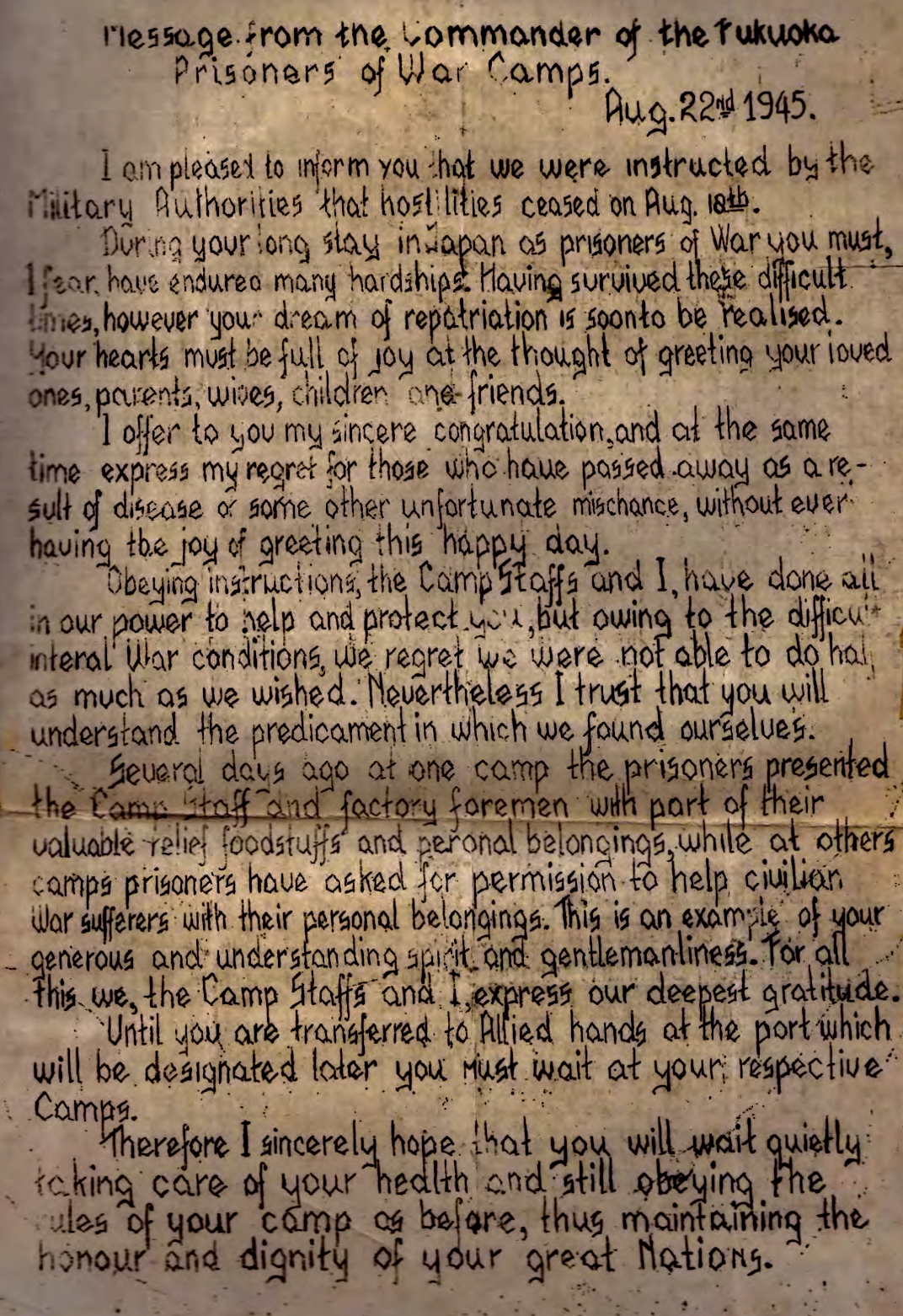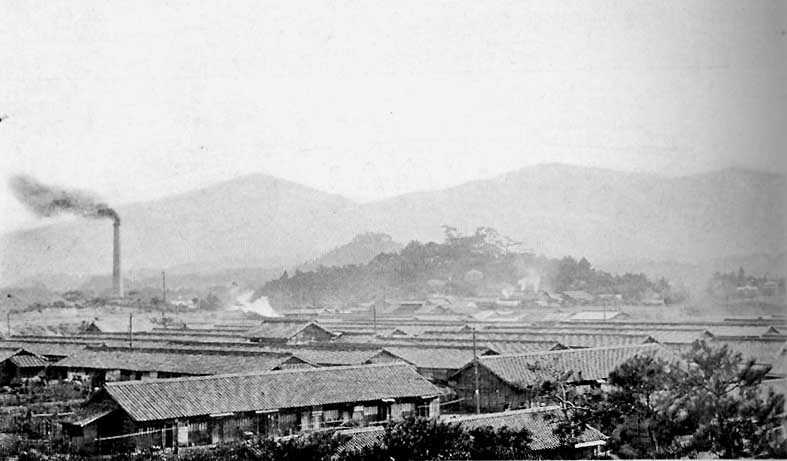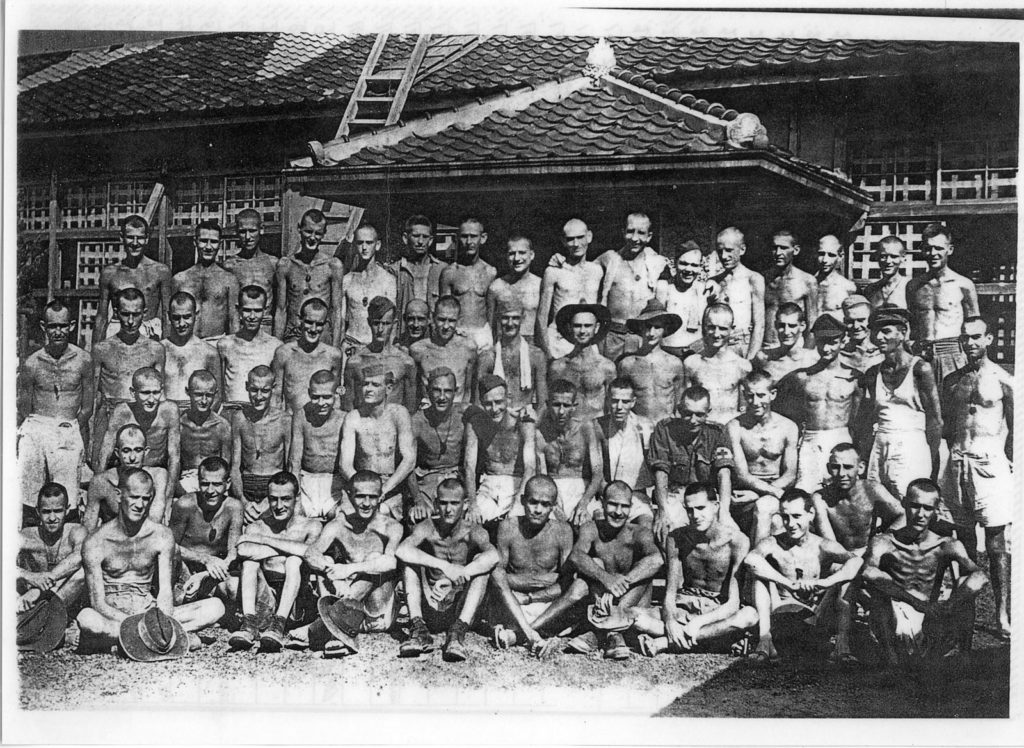Usui, Fukuoka #26 - Japan
Fukuoka 26-B Keisen, Usui
Keisen Yoshikuma Coal Mine Branch Camp (Fukuoka 26-B)
Established as Fukuoka No.26 Branch Camp at Yoshikuma Coal Mine in Keisen-cho, Kaho-gun, Fukuoka Prefecture on May 10, 1945. Camp was on a rise surrounded by a 10 ft fence. Six barracks, slate rooks, each with five 12 mat rooms with hallway running length of each building (sliding door access).
The POWs were used by Aso Mining Company owned by the ASO family.
300 POWs (197 Australian, 101 British and 2 Dutch) were imprisoned at the end of the war.
2 POWs died while imprisonment.
POWS arrived at Usui railroad station, just south of the camp.
POWS were used in coal mining in a formerly closed and dangerous mine. This mine system was- and still is – owned by the ASO family. The son, Taro Aso, was [in 2009] Prime Minister of Japan. The Aso family continues to deny it used any slave labour during the war. In early January 2009, Prime Minister Aso admitted the mine used prisoners but denied any responsibility for any abuse or deaths.
News Story: From the Japan Times – proof of slave labor being used at Aso Mines. In post war report, Aso mines denied responsibility for the two deaths even though they happened over two months after arrival. Both died from effects of severe malnutrition.
View of Fukuoka Camp 26
Group of Australians after VJ Day
Reference http://www.mansell.com/pow_resources/camplists/fukuoka/fuk_26_keisen/fuku_26_main.html
The following information and detailed description of Usui Mining Camp is from “The Story of J Force”
On 8 May 1945 a party of 50 POWs left Kobe House under command Sergeant Ken Martin, 4 Res. Motor Transport to Kawasaki Camp on the other side of Kobe. They then left that camp on 12 May 1945 with members of ‘C’ Force to go to Coal Mines at Usui – No. 26 Camp Fukuoka on the southern Island of Kyushu. Included in this party of 50 men was WX8198 Frank Hinnrichsen and WX6172 Ted Proctor from 2/4th.
200 Australian POWs left Kobe station at 1800 hours on 12 May 1945 to travel south. They were crammed into two carriages with some men standing. They arrived at Moji about 1200 hours the next day having travelled under the sea from Shimonoseki to Moji.
They changed trains at Moji and later two further train changes were made before that arrived at their destination – a mining town.
The district was hilly. Vegatation included a stunted type of pine tree growing on the hills – they were used for mine pit props. The valleys between the hills was devoted mainly to rice growing.
The camp itself was about a mile from the railway station, situated on a bank above the railway line. There were 10 huts connected by a covered passage.
1 & 2. Huts for Japanese Officers & quarters
3,4,5,8,9. were POW’s sleeping quarters
10. Hospital for sick
6. At Passage end – Q.M. Stores.
At outer end – Baths.
7. At Passage end – Cookhouse.
At outer end -Mess room.
Each hut had a passage from the connecting passage and was made up of 7 rooms – each of which contained 8 men. The rooms measured 18 feet by 12 feet.
A Boiler House outside the compound was run by the Mine Company and supplied steam for baths and for cooking.
The camp was enclosed with a 20 foot high wooden fence surmounted by electric wires.
POWs commenced construction of three tunnels into the hill just outside the compound fence, but were never used as shelters.
The 200 Australians arriving on 13 May 1944 were the first inmates at the camp. They were joined a month later by 100 sailors off HMS ‘Essex who arrived from Nagasaki.
Most POWs were sent to work in the coal mines. They walked down a steep incline to arrive at the first level, 500 feet below ground level, then walked along the drives to working areas some of which were 2,800 feet underground.
It was hot below and the men worked only in shorts or loin cloth and rubber boots. A belt and cap was provided for each man who drew an accumulator and lamp from the lamp room before descending into the mine; the accumulator was attached to the belt, the lamp was fixed on the front of the cap.
One of the POWs Charlie La Galle VX40548 from 4 Reserve Motor Transport Driver says he was sent down the mine on the first day. By the end of the day he staggered up from the mine finding it very hard to get his breath. The following week he was sent out with a garden party.
The area where the garden party worked was about a mile and a half from the camp, away from the township. To reach the gardens a path led down the 40 foot embankment beside the camp, crossed over the railway line then the men walked in single file along a narrow track, past rice paddy fields until the hills were reached. The grounds they hoed belonged to the mine company which employed the POWs.
With too many men leaving mine work, POWs had to parade before the Japanese medical officer. La Galle was again ordered down the mine. However on the morning of the third day the mine foreman told the guard La Galle was no good down the mine. So he was again sent to the gardens.
With less food, POWs lost weight.
The POWs did appreciate the hot bath provided each night on return from work.
There were constant air raid warnings as the camp was in a direct line between the mainland and Okinawa. Towards the end of the war, the POWs could hear explosions as bombs fell on Moji, Fukuoka and some other coastal cities nearby. The nights were lit up with the glare from fires and smoke filled the valleys.
On about 6 August 1945 the men saw 480 bombers in flights of nine flying north. They took two hours to pass over the camp.
“It was such a sight! One wondered how long Nippon would take it as these bombers flew on at about 10,000 feet. We could hear the heavy pop pop of their cannon as one Nip plane tried to battle with them. But he was shot down.”
At about 14.30 on 15 August 1945 one of the camp guards came out to where the garden party was working and ordered them all back to camp. The found the POW coal miners were also back from work. They all wondered. Was this the end?
Later that evening the Japanese announced the garden party had worked well but the miners were not so good with their work! Further, all men were to be kept in camp for two days until the guards could get permission to work all the men on the gardens.
The POWs found this information difficult to swallow – the Japanese had tried to get all the men down the mines. They knew something was afoot – they would wait to see if the air raids continued. Usually there would be between one and three air raids nightly. But on this night, all was silent. Surely the war was over.
The next morning Thursday 16 August 1945 at 10.00 hours the POWs were informed the war was over. The guards further informed the men, they were still in charge of the camp. No instructions had been forthcoming from their Higher Command – most telephone lines were out of action due to air-raids.
The Japanese hold on the stored Red Cross Parcels saw the men receive one parcel per 3 men and an issue of Red Cross Clothing previously denied. The men had been in desperate need of clothing and in particular boots – NOW they were each given 2 light shirts, 2 underpants, 1 light suit, boots and an overcoat!
The daily quota of rice was increased. For the first time in months, the POWs had a feeling of being full – change from the weight loss they suffered. They were all issued with 6 days supply of American Red Cross multi-vitamin pills – A, B. C, and D.
The POWs no longer saluted the on duty Japanese guards.
On Friday 24 August 1945 Squadron Leader McCarthy, RAF Medical Officer took over medical duties from the Japanese – the camp was now under POW Command.
They had been allowed to purchase a cow for Yen1,300. She gave about 2 gallons of milk daily – helping the sick over period of about 6 weeks. It was then anticipated there would be adequate food supplies thereafter, so the cow was killed to provide meat for the camp.
One of the Australians ‘Speed’ A.D. Hollingsworth NX54017 of 2/30th Battalion confirmed Usui mining camp was a tough.
The food was bad and insufficient. The paucity of rations led Bill Braddick to comment later in civilian life, that Speed’ was known for the care he gave to a Battalion mate who was 9 years older than himself. If there was any way ‘Speed’ could increase the amount of food that he could get his mate, ‘Speed’ would do so.
Below: The notice sent to all the FUKUOKA POW Camps, Japan at the end of the war. What are your thoughts??



